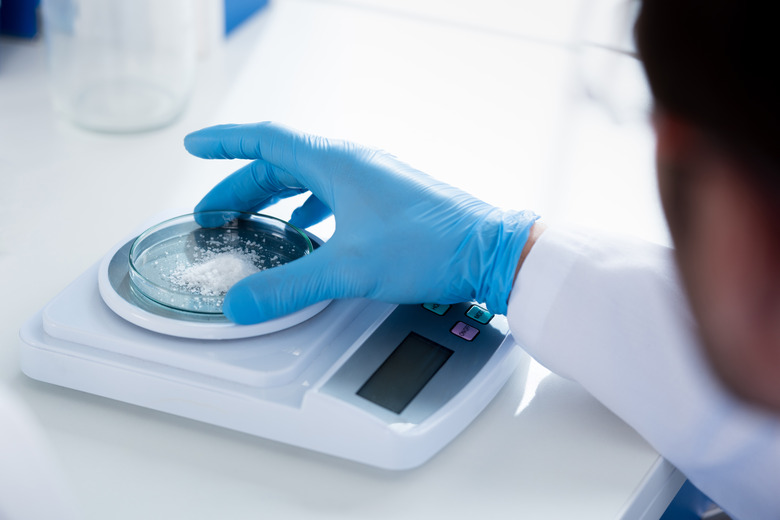How To Calculate The Number Of Molecules
The human brain has a difficult time thinking about both really big numbers and really small numbers. In the chemistry lab, you will often find yourself confronted with both.
Say you have a simple salt solution you will be working with in lab. It's easy enough for you to see the solution. It's clear and aqueous. But, how do you know how many individual molecules of salt there are in this solution?
You can't just look at the solution and figure it out. Counting molecules in a solution isn't as simple as counting jelly beans in a jar. You can't even pop a sample of the solution under a light microscope to try and see the molecules. They're simply too small!
Then how can you account for how many salt molecules there are? The key is Avogadro's number.
What Is Avogadro's Number?
What Is Avogadro's Number?
Inside your salt solution not only can you not see the molecules, but there are tons of them. In fact, there are so many that it can be very difficult to really understand the number of them. You're dealing with enormous numbers of a very tiny particle. But, chemistry requires the knowledge of how many particles for many reasons, among which include predicting reactions and making solutions.
You need to know the number of molecules and how this relates to mass since, more often than not, when you make a solution, you are weighing out the component in question. For example, you do not count the individual number of molecules you need in a salt solution. Instead you weigh out the amount of solute that corresponds to the number of molecules you want.
The mole allows a bridge between the unfathomable world of huge numbers of tiny molecules and being able to actually weigh substances out and work with them. A mole of a substance contains 6.022 x 1023 particles of that substance. This is Avogadro's number.
A mole is thus a collective number. It's similar to another collective number you may be familiar with: a dozen. A dozen can refer to anything: a dozen donuts is always twelve donuts, and a dozen flamingos is always twelve flamingos.
In the same way, a mole of donuts would be 6.022 x 1023 donuts, and a mole of flamingos would be 6.022 x 1023 flamingos. A mol of NaCl would also be a 6.022 x 1023 molecules of NaCl.
The relationship between moles and mass is known as molar mass or the number of grams in one mole of a substance. The molar mass for any element can be found under the symbol on the periodic table.
For example, the molar mass of carbon is 12.01 g/mol. This means that in one mole of carbon there are 12.01 grams of carbon.
Using Avogadro's Number to Calculate the Number of Molecules
Using Avogadro's Number to Calculate the Number of Molecules
Say you have 2 moles of NaCl. How many molecules of NaCl is that? Here's where you can use Avogadro's number:
\(\mathrm{2mol\enspace NaCl\Biggl(\dfrac{6.022\times10^{23}\enspace molecules\enspace NaCl}{1mol}\Biggr)=1.2\times10^{24}\enspace molecules\enspace NaCl}\)
Thus, 2 moles of NaCl contain 1.2 x 1024 molecules of NaCl.
What about if instead of 2 moles, you were given 2 grams of NaCl. How many molecules of NaCl does that contain?
To figure this out, you will need the molar mass of NaCl which is 58.44 g/mol. First, convert the grams to moles using the molar mass and then use Avogadro's number to find the number of molecules:
\(\mathrm{2g\enspace NaCl\Biggl(\dfrac{1mol\enspace NaCl}{58.44g\enspace NaCl}\Biggr)\Biggl(\dfrac{6.022\times10^{23}\enspace molecules\enspace NaCl}{1mol}\Biggr)=2.1\times10^{22}\enspace molecules\enspace NaCl}\)
This calculation tells you that there are 2.1 x 1022 molecules of NaCl in 2 grams of NaCl.
Cite This Article
MLA
Gupta, Riti. "How To Calculate The Number Of Molecules" sciencing.com, https://www.sciencing.com/calculate-number-molecules-6150341/. 8 March 2020.
APA
Gupta, Riti. (2020, March 8). How To Calculate The Number Of Molecules. sciencing.com. Retrieved from https://www.sciencing.com/calculate-number-molecules-6150341/
Chicago
Gupta, Riti. How To Calculate The Number Of Molecules last modified August 30, 2022. https://www.sciencing.com/calculate-number-molecules-6150341/
